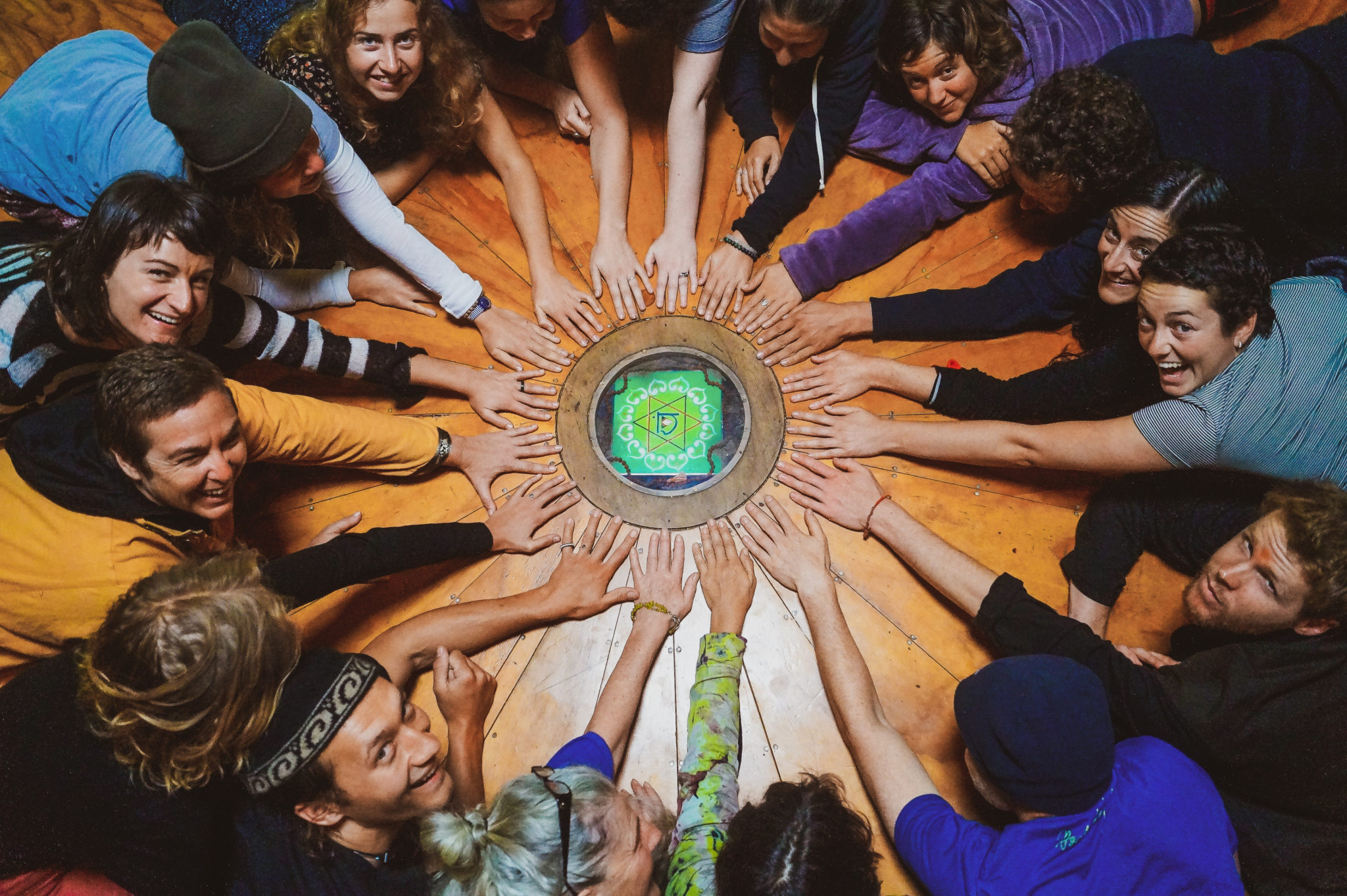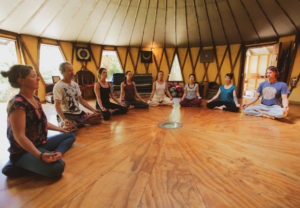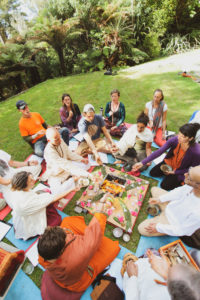
Satsang: Maintaining Connection while in Isolation
The Sanskrit root ‘sat’ means highest truth or wisdom and ‘sang’ is associated with ‘sangha’, signifying company or association. Satsang therefore translates as ‘being in the company or presence of ‘truth’. It could also be thought of as being in a family of those who are seeking truth.
Human beings are naturally social. Despite strongly held values of independence predominant in our modern society, we often gravitate towards connection and support in groups, whether in a yoga class, a rugby game, a party or a gym. Whichever environment or group of people we spend time with, at a subtle level, it influences us.

Being in the physical presence of a great person or a group of people whom you feel inspired by or resonate with is ideal, however, it is not always possible. As we are currently in the midst of covid-19, many of us are in isolation and some are spending this time completely alone. It’s important that we continue to encourage positive connection in our lives, to cultivate inspiration and uplift ourselves during these challenging times.
In this day and age of technological advancement, satsang can take place through video conferencing, online meetings, virtual lectures or movies. You may even like to start your own satsang group online and choose particular topics, readings, great beings or teachings to discuss and contemplate.
The essence of satsang is similar to the example of the grandfather clock. Through many experiments we know that when the grandfather clock is put in the same room with other small clocks, after some time, all the clocks align to the same rhythm. Over time, we attune with whatever person or group we share company with. Being with positive people can be a wonderful support on the path to inspiring spiritual growth or the highest expression of ourselves. This is the essence of satsang.The Art of Living web-site says it simply, “satsangs are gatherings where scattered minds unite through music, meditation, and wisdom to experience a higher state of consciousness.”

Similar to the grandfather clock, the foundation of satsang is that the company we keep can determine our aspirations and focus. If we pass time with negative people, we may be dragged down. If we are in the company of ego-driven or greedy people, it can feed our own negative tendencies.
The reality is, we all still have instinctual qualities lurking around, such as anger, greed, desire, fear. These drives are there to protect us from danger, to make sure we have enough to eat, to stimulate procreation and to ensure our survival. However, they are not always conducive to the cultivation of peace, compassion and happiness.
When there is a desire to make positive life change, deepen a practice or unfold inner knowledge, as is often the case in yoga practitioners, then it can be highly beneficial to be in environments where topics of an inspiring nature are discussed, or to spend time with extraordinary people.
We often overlook the positive in life, since those experiences are not a threat to our survival. Therefore being positive requires more effort. By mixing with people who focus on or model higher qualities such as giving, regular practice, equanimity or joy, we can be influenced to express these qualities in our own lives.
I firmly believe that the answers to all questions and the universal truth lie within us. However, the inner voice and wisdom can sometimes be veiled by superimposed ideas, negative experiences that have created protective armour, cultural cloaks or past experiences that have blocked us.

One powerful way to lift oneself out of instinctive drives and reconnect to our own higher voice is through satsang. Even one satsang can inspire creativity, awaken a new direction, and unfold greater potential or renewed meaning in life.
Satsang has been revered through the ages. It is mentioned in the Vedas, the ancient texts which layout Hindu philosophy and form the root of many yogic practices. It is also revealed in Indian Epic stories and poems, such as the Ramayana, where it is advised to “Take a bath in the holy water of satsang and purify the inner being.” http://www.yogamag.net/archives/1983/emay83/sat583.shtml
Other cultures such as Native American and Aboriginal Tribes, have also historically valued gathering in groups, sharing life teachings and higher vision through stories.
Shankaracharya, who is recognised as unifying Hinduism said, “The company of the wise, even for a moment, becomes the boat to cross the ocean of samsara (the illusionary world)” From Upasana, In the Presence of the Divine
Here are some ways you can experience Satsang while in the physical presence of others either online or in person:
- A talk or teaching on a specific topic – Satsang can be an online lecture or teaching on a particular topic. Those who have depth in that topic are able to reveal expertise and inspiration on that particular subject.
- Study and contemplation of saints or inspiring people – Whether these people lived in the past or exist at present, studying their lives through reading books, watching movies about them or engaging in an online study group based on their teachings can nourish us and guide us on how to express these qualities in our own lives. By seeing through their eyes, hearing through their ears, and feeling through their experiences, it can reinforce higher ways of thinking and being and inspire us to integrate their ideas into our own lives.
- Reading epics, spiritual or religious books – These types of scriptures and stories, often have characters and morals that provide an example of how to live a superior life.
- Chanting –Another way to experience elevated states of being is to chant as a group. There are many online chanting groups that meet through Zoom or Skype. Chanting has many positive physiological benefits, such as deepening the breath, slowing down the brain waves as well as the positive influence of sound vibration. When done as a group, the collective mood can be quickly elevated. Our online shop offers a selection of chanting MP3s you can listen to and practice with whomever is in your bubble.
- Group Discussions – Satsang can take the shape of being with a group of people and discussing or contemplating ‘truth’. The group may discuss a particular poem, quote, teaching or question. By sharing ideas and experiences with others, collective learning can occur and a sense of support on our path imparted.
- Questions and Answers – A senior teacher or person with many years of experience in a particular field or topic may answer questions related to spiritual life. Someone who has walked the path before us sheds light on the topic. This is similar to taking guidance from an expert mountain guide. The subtle truths of our own nature can sometimes be like a steep icy mountain pass and having expert information and knowing the right way to traverse the route, can be vital.
- Being in the presence of great people –Spending time in the presence of extraordinary people, whether dedicated to humanitarian, environmental, spiritual or religious work, may greatly motivate our own path.
- Transmission – We often experience our world through intellect. Satsang can give us something that we cannot see and cannot necessarily define. Sitting with people of a high vibration allows one to immerse in their vibrations and a transmission of energy can occur. Basic physics describes the world as a great variety of different fields that make up the entire world. As expressed by Physicist Don Lincoln, “Everything—and I mean everything—is just a consequence of many infinitely-large fields vibrating. The entire universe is made of fields playing a vast, subatomic symphony. Physicists are trying to understand the melody”. At the beginning of a satsang, everyone enters with their own vibration, problems, thoughts. It is a cacophony yet, at the end, harmony can be felt. I have had this experience personally many times. My job in the Indian ashrams has often been to video or photograph satsangs of our spiritual inspirers. They are sometimes given in Hindi, which I cannot even understand intellectually, but nevertheless, I leave feeling elevated and connected with the others who attended. I can only explain this as a tuning into the energy field.

The benefits of satsang are many. Sometimes we are carried by the experience and depth of the group or the leader of the satsang and, at other times, we may become a catalyst for the growth and inspiration of others. Satsang can provide a sense of community. This is called sangha or spiritual family. Doubts on the path may arise, which is a natural part of the process of self discovery and satsang can help us to get clarity. We learn from others and may find that most practitioners face similar challenges. Sharing can motivate one to continue on the path, to have faith or kindle passion for spiritual life.
In the same way that the food we eat feeds the body and can help to generate health and well-being, or sickness, whatever we feed ourselves with mentally and energetically influences our state of mind and emotion. Satsang is one method to feed our bodies, minds and energy fields with positivity and hunger for higher life. Make satsang part of your daily ritual, by reading a few paragraphs of a book or great person’s life each morning. Listen to a snippet of a satsang before going to work or upon returning.
However, It is not enough to simply hear teachings or read about a great person’s life. It is necessary to take the teaching and examples and embody them. It is not sufficient to look at Mother Teresa, Gandhi, Nelson Mandela or our favorite Yogi and say, “aren’t they amazing” and then continue to concentrate on me, myself and I or turn a blind eye to those in need. While one person may not be able to fix all the world’s problems, it is important to at least begin practicing by planting a little positive seed and watering it with actions, so that the inspiration gained in satsang, can gradually take root and manifest in our lives.


Direct Quote References
